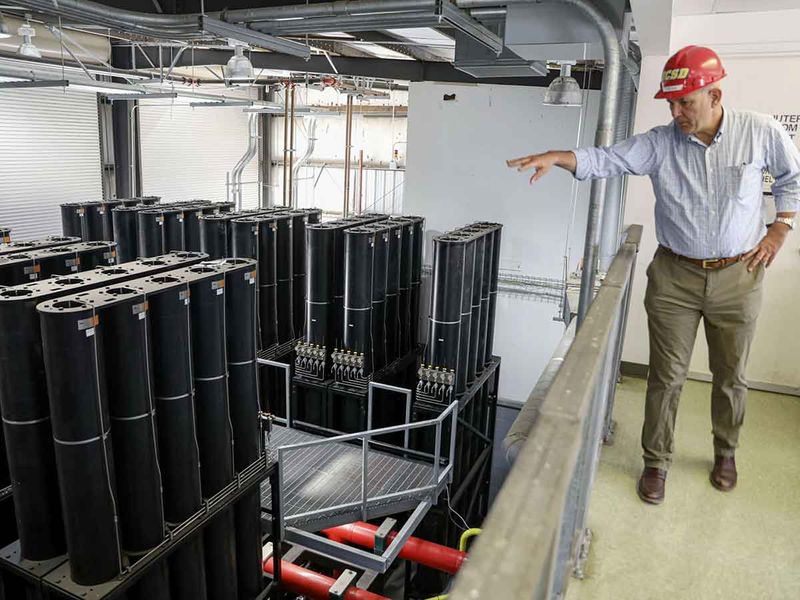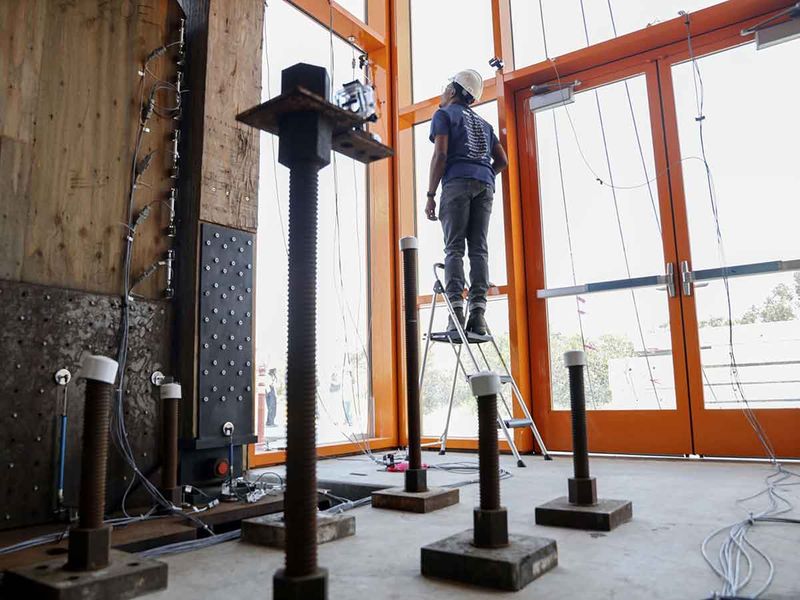One sunny morning final month, an earthquake jolted northeast San Diego. Minutes later, one other temblor hit, inflicting a 10-story wooden constructing to sway.
The quakes, although, had been triggered by a pc and the shaking was confined to a 1,000-square-foot platform on which the constructing – a full-size take a look at mannequin – stood.
The construction is the tallest ever subjected to simulated earthquakes on the world’s largest high-performance “shake desk,” which makes use of hydraulic actuators to thrust the metal platform via six levels of movement to copy seismic drive. The shake-table trials at a College of California at San Diego facility are a part of the TallWood Undertaking, an initiative to check the seismic resiliency of high-rise buildings fabricated from mass timber. An engineered wooden constructing materials, mass timber is more and more in style as a extra sustainable different to carbon-intensive concrete and metal.
Picture Credit score: Bloomberg
By the tip of the testing interval in August, the mock-up may have been subjected to greater than 100 seismic occasions in the course of the $3.7 million experiment.
“You are placing a constructing via the variety of quakes it can by no means, ever expertise until it is round for five,000 years,” says Thomas Robinson, founding principal of Lever Structure, a Portland, Ore., agency that helped design the TallWood construction.
Current adjustments to buildings codes within the US allow mass timber buildings as tall as 18 tales. However unknown till now could be how such high-rises would fare in earthquake-prone areas of the world like California.
Like a deconstructed rocket prepared for liftoff
On the primary day of testing in Might, anticipation runs via a crowd of hard-hatted architects, engineers and researchers as they collect a protected distance from the constructing, which stands on the shake desk like a deconstructed rocket prepared for liftoff. A financial institution of video cameras is pointed on the construction and a drone buzzes overhead.
The primary three tales of the 112-foot-high constructing are clad in silver and orange panels that body glass home windows. The remainder of the constructing is open-air, with every flooring containing 4 “rocking partitions” engineered to attenuate structural harm from earthquakes. Engineers additionally constructed inside partitions and staircases designed to outlive extreme shaking and put in sensors all through the constructing.
Two five-story, rust-colored steel “safety towers” flank the constructing on one aspect and cables tether it to the bottom on the alternative aspect to interrupt its fall if the construction collapses throughout testing.
This morning, engineers have programed the shake desk to breed two devastating earthquakes. The primary is the 6.7-magnitude Northridge quake that struck Los Angeles in 1994 and that, in 20 seconds, brought about greater than $40 billion in damages as buildings and freeways collapsed, killing 60 individuals. Greater than 2,400 individuals misplaced their lives within the second catastrophe, the 7.7-magnitude Chi Chi quake that hit Taiwan in 1999 and crumbled concrete-and-steel high-rise buildings.
Applause erupts
Loudspeakers broadcast the countdown to the primary quake: “Northridge. 3D movement. Northridge 3D movement. 5, 4, three, two, one.” The constructing begins to sway back and forth, creaking and groaning in the course of the minute-long simulation. Applause erupts as mission management proclaims “Northridge full” and the constructing involves a relaxation.

Picture Credit score: Bloomberg
Six minutes later one other countdown begins. The much more highly effective Chi Chi quake simulation shakes the constructing back and forth and backward and forward. The checks lasts for a minute, twice so long as the precise quake that left 100,000 individuals homeless and ranks as essentially the most highly effective temblor to strike Taiwan within the twentieth century. It’s the kind of catastrophic quake that Californians name “the Massive One.”
After a half-hour, inspectors deem the constructing protected to enter. On the third flooring, Shiling Pei, the TallWood Undertaking’s principal investigator, examines the partitions and flooring. “That is precisely the outcomes that we’re in search of, which is not any structural harm,” says Pei, an affiliate professor of civil and environmental engineering on the Colorado Faculty of Mines. “Which means the constructing could possibly be reoccupied shortly.”
Earthquake’s financial and social impacts
Avoiding costly structural repairs and placing buildings swiftly again into service reduces an earthquake’s financial and social impacts, in keeping with Robinson, who famous that the outside partitions of the TallWood constructing remained in alignment regardless of the extreme shaking. “It is often proper the place the corners meet the place you get huge harm,” he says.
The truth that there was minimal affect to nonstructural elements of the constructing, equivalent to staircases and facades, can be vital, in keeping with Pei. “You see the nonstructural system opened up just a little bit,” he says, pointing to an inside wall. “However repairing that won’t be that pricey, simply patching drywall.”
The researchers are testing 4 totally different constructing facade assembles. Three are drywall-covered metal frames with aluminum composite panels as the outside end, every secured to the constructing differently. The fourth facade is a glass curtain wall. One of many aluminum panels popped out in the course of the seismic checks, however the facades all remained hooked up to the constructing.
The TallWood constructing’s skill to resist back-to-back simulated earthquakes speaks to the pure flexibility of wooden development and the architectural techniques designed to strengthen the construction, such because the rocking partitions. The north-south rocking partitions are constructed from mass plywood panels comprised of spruce, pine and fir whereas the east-west partitions are Douglas fir cross-laminated timber. Metal rods anchor the partitions to the muse. When an earthquake strikes, the partitions rock forwards and backwards to dissipate seismic vitality and when the shaking stops, the metal rods pull the constructing again to heart.
Do not anticipate to see supertall mass timber buildings
A lot of the mass timber within the construction got here from Boise Cascade tree plantations in Oregon. “With current constructing code adjustments, we see this as only a nice market to be in,” says Daniel Cheney, director of engineering on the wooden merchandise firm. “As much as that time, it was nonetheless concrete for business buildings. Now there’s much more alternatives.”
Simply do not anticipate to see supertall mass timber buildings. Pei and Robinson say that above 18 tales, a mass timber construction lacks the stiffness to resist winds that buffet excessive towers.

Picture Credit score: Bloomberg
TallWood (formally, the Pure Hazards Engineering Analysis Infrastructure TallWood Undertaking) is run by a consortium of universities and has acquired funding from the Nationwide Science Basis and US Forest Service in addition to personal building-industry firms.
When the quake trials are accomplished, the construction will likely be dismantled and elements of it recycled to assemble different take a look at buildings. The researchers anticipate the outcomes of the shake checks will spur development of extra high-rise mass timber buildings by assuring architects, builders and authorities officers of their sturdiness.
“I feel mass timber is a good resolution for sustainability, for economics,” says Keri Ryan, an engineering professor on the College of Nevada at Reno, who led the workforce that developed the nonstructural elements of the TallWood constructing. “So I hope that this actually helps get individuals excited that we have a resilient mass timber system that works.”